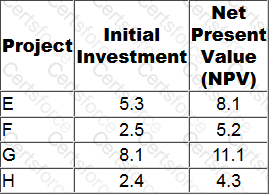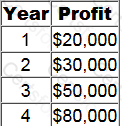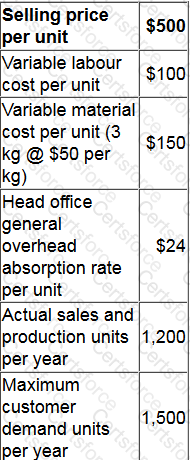A manager must decide which one of three projects should be implemented. For each project the possible outcomes and their associated probabilities can be estimated reliably. The manager has decided to make the decision based solely on which project has the highest expected value of profit.
Which of the following statements are correct?
Select ALL that apply.
A company has a maximum of $2 million to invest and has identified four viable projects, E, F, G and H.
The initial investment for each of the projects is the maximum amount that can be invested in the project, but any amount up to the maximum can be invested. The projects are divisible.
The projects have been evaluated using net present value, as below. All figures are $ millions.

In which project should the company invest $2 million?
A project requires an initial investment of $160,000 in an asset for which the annual depreciation charge will be $40,000. The forecast profits from the investment are as follows.

What is the payback period for the project in years? Give your answer to two decimal places.
One of an investment centre's products is sold on an external market. Output is limited because the specialist machine that manufactures the product is operating at full capacity.
Current data for the product are as follows.

Investigations have identified that more rigorous maintenance of the machine at an annual cost of $5,000 would reduce the number of breakdowns and increase its capacity to 1,300 units per year.
There would be no change in the selling price if more units were sold. Any additional labor hours would be paid a premium of 25%. A discount of 2% of the cost of all materials purchased is available if the company increases its purchases to 3,700 kg or more per year.
What would be the increase in the investment centre's annual controllable profit if more rigorous maintenance is undertaken?
SkillWeave Industries are focused on managing the risk of selling their cars to the region due to economic turmoil, and have now begun using funds from sales in the region to fund supplier purchases from that region to
reduce the risk from the volatile currency. However, SkillWeave want to go a step further and make the risk even less sizeable.
Which of the following is a method by which SkillWeave can operate in the market and transfer the risk of exchange rate exposure to another party?
There is a 60% probability of a project yielding a positive net present value (NPV) of $280,000 and a 30% probability of it yielding a positive NPV of $140,000.
The only other possible outcome is that the project will yield a negative NPV of $160,000.
What is the expected value of the project's NPV?
Which basis of transfer pricing retains the full autonomy of divisional managers?
K Supermarket spends $80,000 per year on checking and processing receipts of inventory. Annual warehouse costs are a further $70,000 per year. These costs are currently treated as fixed overheads in the company's costing system.
As an experiment, the company is preparing a direct profitability analysis of a small range of products, including fresh grapes.
K Supermarket receives a total of 3,600 deliveries every year. 20% of these deliveries are of perishable goods such as grapes. It takes twice as long to process a delivery of perishable goods compared to a normal delivery because perishable goods have to be checked more carefully.
Half of the warehouse costs are for the chilled store that is used to store perishable goods. At any time, the chilled store has 800 kilos of perishable goods in stock.
K Supermarket receives 150 deliveries of grapes every year. Each delivery is for 100 kilos of grapes. The grapes spend an average of two days in the chilled store before they are sold.
Calculate the total cost per kilo of checking, processing and storing grapes that should be taken into account in determining the profitability of grapes.
Give your answer to the nearest whole cent.
A company is investing $150,000 in a project which will yield an annual cash inflow of $40,000 for eight years. The company's cost of capital is 10%.
To the nearest $100, what is the project's equivalent annual net present value?
An investment centre manager is considering the purchase of a new machine. If purchased, the new machine would replace an existing one that is used to manufacture one of the investment centre's existing products.
The new machine would incur $800 per month additional running costs; this includes $300 per month of additional depreciation.
The new machine would save on direct labor time. This means that the fixed production overhead absorbed by the product on the basis of direct labor hours would reduce by $100 per month.
What is the total cost of the above that is relevant to the decision to purchase the machine?